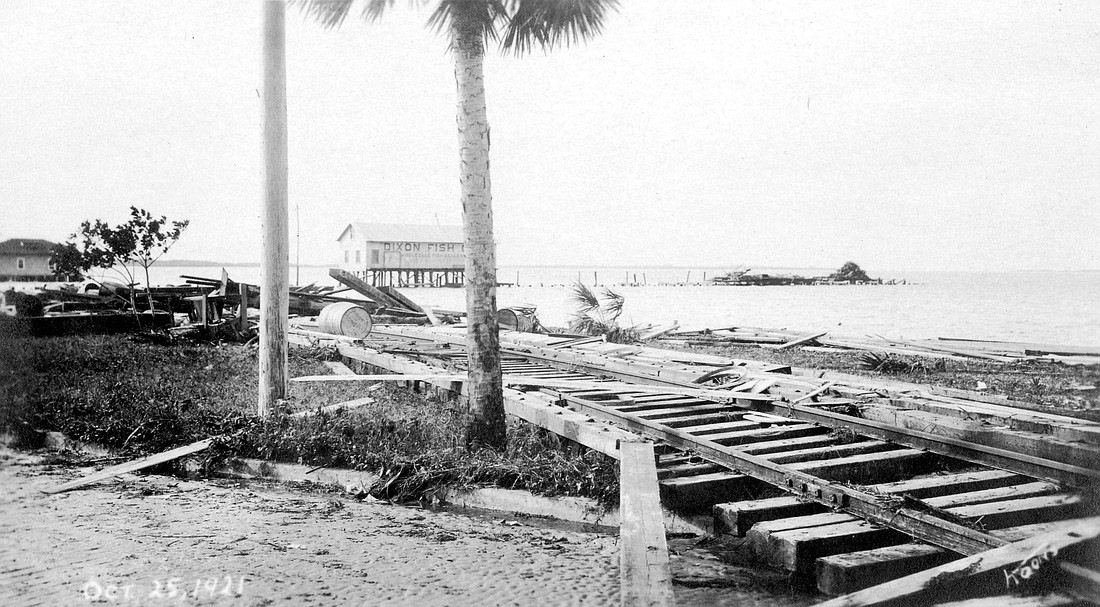- May 2, 2024
-
-
Loading

Loading

William Whitaker, the first settler in Sarasota County, began as a fishmonger, hawking dried mullet to Cuban traders. And by the early 1900s, the region was dotted with fish shacks, the stink of which complicated progressives’ plans to build a tourist haven.
But, the winds of change hit Sarasota — literally — when the Tampa Bay Hurricane of 1921 devastated commercial fishing operations and left a fresh canvas for resorts. It also may also have triggered one of the most controversial environmental topics on Siesta Key.
The sixth hurricane of 1921, which had winds of up to 140 mph, boomeranged into the Gulf of Mexico in October, before whipping east and tearing through the middle of Florida, according to Atlantic tropical cyclone tracking data collected by the National Hurricane Center. There was about $10 million worth of damage to Florida, according to news reports from October 1921.
A 7-foot storm surge submerged Siesta Key and the roads on either side of the island’s sole bridge were destroyed, contributing to the $150,000 worth of damage reported by Mayor Arthur Edwards after the storm. Adjusted for inflation, that’s $1.9 million. The bridge was rendered temporarily useless only four years after the connection was built.
The commercial fishing industry went belly-up after the hurricane, said Sarasota County History Center Director Jeff LaHurd. Nearly every fishing camp and run boat was lost. Cast nets, used to snare mullet, were impaled with shrapnel or swept into the bay, an estimated loss of thousands of dollars.
When Edwards issued a proclamation calling for volunteers of men and trucks to begin cleaning debris — which included several boats — along Gulfshore Avenue, horrified longshoremen found a mangled mass of steel and waterlogged wood by Sarasota Bay. It was the remains of the lifeline of the fishing industry: railroad tracks used to cart supplies and dried fish to and from the bustling fish camps, according to Karl Grismer’s 1946 book “The Story of Sarasota.”
But, with one industry in ruins, the current enterprise that dominates Siesta Key had room to bloom. Tourism was difficult to push initially, because there were few resorts in Sarasota County. Further, commercial fishing crowded out leisure angling, a major travel activity in the early 1900s, and pumped the stench of dead and drying fish throughout downtown Sarasota. But, the hurricane’s decimation of most fishing infrastructure and the formation of a progressive governing body made pursuing tourism advantageous.
The first Sarasota County Commission, which was established in 1921, encouraged development with the help of statesman Harry Higel. It authorized more spending on public schools, which attracted transplants from nearby Bradenton, and authorized public spending for roads and bridges.
The hurricane was the second regional tragedy of 1921, a year in which the beloved Sarasota developer Higel was mysteriously murdered. The ever-unlucky Higel, who in 1915 built Hotel Higelhurst on the barrier island he named Siesta Key, would never get to see Siesta transform into the vision for which he ardently fought — one that roped in $3.1 million in tourist tax dollars since October 2011.
“I believe the Hurricane of 1921 made Sarasota what it is today,” LaHurd said.
Editor’s note: Jeff LaHurd and the Sarasota County History Center assisted with the research in this story.
The 1921 Atlantic Hurricane Season
Storm Name: Peak Intensity
Hurricane One: Category 1
Hurricane Two: Category 1
Hurricane Three: Category 3
Hurricane Four: Category 1
Tropical Storm Five: —
The Tampa Bay Hurricane of 1921: Category 5
Tropical Storm Seven: —
Data retrieved from the National Hurricane Center